Synthesis, Crystal Structures, and Photoluminescent Properties of Two Supramolecular Architectures Based on Difunctional Ligands Containing Imidazolyl and Carboxyl Groups
Abstract
:1. Introduction
2. Results and Discussion
2.1. Structural Description of [Cd(L1)2(H2O)]n (1)
2.2. Structural Description of [Ni(L2)2(H2O)]n (2)
2.3. Thermal Analysis and Powder X-ray Diffraction Analysis
2.4. Photoluminescent Property
3. Experimental Section
3.1. Materials and Instrumentation
3.2. Synthesis of [Cd(L1)2(H2O)]n (1)
3.3. Synthesis of [Ni(L2)2(H2O)]n (2)
3.4. Crystal Structure Determination
4. Conclusions
Acknowledgments
Author Contributions
Conflicts of Interest
References
- Zhao, T.; Heering, C.; Boldog, I.; Domasevitch, K.V.; Janiak, C. A view on systematic truncation of tetrahedral ligands for coordination polymers. CrystEngComm 2017, 19, 776–780. [Google Scholar] [CrossRef]
- Wu, Y.L.; Qian, J.; Yang, G.P.; Yang, F.; Liang, Y.T.; Zhang, W.Y.; Wang, Y.Y. High CO2 uptake capacity and selectivity in a fascinating nanotube-based metal−organic framework. Inorg. Chem. 2017, 56, 908–913. [Google Scholar] [CrossRef] [PubMed]
- Zhao, D.; Zhang, J.; Yue, D.; Lian, X.; Cui, Y.; Yang, Y.; Qian, G. A highly sensitive near-infrared luminescent metal–organic framework thermometer in the physiological range. Chem. Commun. 2016, 52, 8259–8262. [Google Scholar] [CrossRef] [PubMed]
- Zhao, D.; Cui, Y.; Yang, Y.; Qian, G. Sensing-functional luminescent metal–organic frameworks. CrystEngComm 2016, 18, 3746–3759. [Google Scholar] [CrossRef]
- Zhai, Q.G.; Bu, X.; Mao, C.; Zhao, X.; Feng, P. Systematic and dramatic tuning on gas sorption performance in heterometallic metal−organic frameworks. J. Am. Chem. Soc. 2016, 138, 2524–2527. [Google Scholar] [CrossRef] [PubMed]
- Chen, S.S. The roles of imidazole ligands in coordination supramolecular systems. CrystEngComm 2016, 18, 6543–6565. [Google Scholar] [CrossRef]
- Zeng, W.; Jiang, J. Synthesis and crystal structures of two novel O, N-containing spiro compounds. Crystals 2016, 6, 69–75. [Google Scholar] [CrossRef]
- Chen, S.S.; Sheng, L.Q.; Zhao, Y.; Liu, Z.D.; Qiao, R.; Yang, S. Syntheses, structures, and properties of a series of polyazaheteroaromatic core-based Zn(II) coordination polymers together with carboxylate auxiliary ligands. Cryst. Growth Des. 2016, 16, 229–241. [Google Scholar] [CrossRef]
- Shi, Q.; Xu, W.J.; Huang, R.K.; Zhang, W.X.; Li, Y.; Wang, P.; Shi, F.N.; Li, L.; Li, J.; Dong, J. Zeolite CAN and AFI-type zeolitic imidazolate frameworks with large 12-membered ring pore openings synthesized using bulky amides as structure-directing agents. J. Am. Chem. Soc. 2016, 138, 2524–2527. [Google Scholar] [CrossRef] [PubMed]
- Schmieder, P.; Denysenko, D.; Grzywa Magdysyuk, M.O.; Volkmer, D. A structurally flexible triazolate-based metal–organic framework featuring coordinatively unsaturated copper(I) sites. Dalton Trans. 2016, 45, 13853–13862. [Google Scholar] [CrossRef] [PubMed]
- Nguyen, N.T.T.; Lo, T.N.H.; Kim, J.; Nguyen, HT.D.; Le, T.B.; Cordova, E.; Furukawa, H. Mixed-metal zeolitic imidazolate frameworks and their selective capture of wet carbon dioxide over methane. Inorg. Chem. 2016, 55, 6201–6207. [Google Scholar] [CrossRef] [PubMed]
- Suckert, S.; Germann, L.S.; Dinnebier, R.E.; Werner, J.; Näther, C. Synthesis, structures and properties of cobalt thiocyanate coordination compounds with 4-(hydroxymethyl)pyridine as Co-ligand. Crystals 2016, 6, 38–54. [Google Scholar] [CrossRef]
- Chen, S.S.; Wang, P.; Takamizawa, S.; Okamura, T.A.; Chen, M.; Sun, W.Y. Zinc(II) and cadmium(II) metal-organic frameworks with 4-imidazole containing tripodal ligand: sorption and anion exchange properties. Dalton Trans. 2014, 43, 6012–6020. [Google Scholar] [CrossRef] [PubMed]
- Chen, S.S.; Chen, M.; Takamizawa, S.; Chen, M.S.; Su, Z.; Sun, W.Y. Temperature dependent selective gas sorption of the microporous metal-imidazolate framework [Cu(L)] [H2L = 1,4-di(1H-imidazol-4-yl) benzene]. Chem. Commun. 2011, 47, 752–754. [Google Scholar] [CrossRef] [PubMed]
- Chen, S.S.; Chen, M.; Takamizawa, S.; Wang, P.; Lv, G.C.; Sun, W.Y. Porous cobalt(II)-imidazolate supramolecular isomeric frameworks with selective gas sorption property. Chem. Commun. 2011, 47, 4902–4904. [Google Scholar] [CrossRef] [PubMed]
- Chen, S.S.; Liu, Q.; Zhao, Y.; Qiao, R.; Sheng, L.Q.; Liu, Z.D.; Yang, S.; Song, C.F. New metal-organic frameworks constructed from the 4-imidazole-carboxylate ligand: structural diversities, luminescence, and gas adsorption properties. Cryst. Growth Des. 2014, 14, 3727–3741. [Google Scholar] [CrossRef]
- Chen, J.; Li, C.P.; Du, M. Substituent effect of R-isophthalates (R = –H, –CH3, –OCH3, –tBu, –OH, and –NO2) on the construction of CdII coordination polymers incorporating a dipyridyl tecton 2,5-bis(3-pyridyl)-1,3,4-oxadiazole. CrystEngComm 2011, 13, 1885–1893. [Google Scholar] [CrossRef]
- Sheng, Y.W.; Wang, Y.; Okamura, T.A.; Sun, W.Y.; Ueyama, N. Synthesis, crystal structure and nonlinear optical property of cadmium(II) and copper(II) complexes with novel chiral ligand. Inorg. Chem. Commun. 2007, 10, 432–436. [Google Scholar] [CrossRef]
- Guo, X.Z.; Zhang, Z.Y.; Li, Z.L.; Shi, S.S.; Chen, S.S. Synthesis, crystal structures, and properties of two coordination polymers built from imidazolyl and carboxylate ligands. Crystals 2017, 7, 73. [Google Scholar] [CrossRef]
- Kreno, L.E.; Leong, K.; Farha, O.K.; Allendorf, M.; Van Duyne, R.P.; Hupp, J.T. Metal–organic framework materials as chemical sensors. Chem. Rev. 2012, 112, 1105–1125. [Google Scholar] [CrossRef] [PubMed]
- Peng, Y.F.; Zhao, S.; Li, K.; Liu, L.; Li, B.L.; Wu, B. Construction of Cu(II), Zn(II) and Cd(II) metal–organic frameworks of bis(1,2,4-triazol-4-yl)ethane and benzenetricarboxylate: syntheses, structures and photocatalytic properties. CrystEngComm 2015, 17, 2544–2552. [Google Scholar] [CrossRef]
- Sun, Y.X.; Sun, W.Y. Zinc(II)– and cadmium(II)–organic frameworks with 1-imidazole-containing and 1-imidazolecarboxylate ligands. CrystEngComm 2015, 17, 4045–4063. [Google Scholar] [CrossRef]
- Meng, F.; Zhang, M.; Shen, K.; Li, Y.; Zheng, H. A series of MOFs based on a triangular tri(4-pyridylphenyl)amine ligand combined with carboxylate or nitrate auxiliary ligands. Dalton Trans. 2015, 44, 1412–1419. [Google Scholar] [CrossRef] [PubMed]
- Chen, S.S.; Qiao, R.; Sheng, L.Q.; Zhao, Y.; Yang, S.; Chen, M.M.; Liu, Z.D.; Wang, D.H. Cadmium(II) and zinc(II) complexes with rigid 1- (1H-imidazol-4-yl)-3-(4H-tetrazol-5-yl)benzene and varied carboxylate ligands. CrystEngComm 2013, 15, 5713–5725. [Google Scholar] [CrossRef]
- Li, L.N.; Wang, S.Y.; Chen, T.L.; Sun, Z.H.; Luo, J.H.; Hong, M.C. Solvent-dependent formation of Cd(II) coordination polymers based on a C2-symmetric tricarboxylate linker. Cryst. Growth Des. 2012, 12, 4109–4115. [Google Scholar] [CrossRef]
- Song, S.Y.; Song, X.Z.; Zhao, S.N.; Qin, C.; Su, S.Q.; Zhu, M.; Hao, Z.M.; Zhang, H.J. yntheses, structures and physical properties of transition metal–organic frameworks assembled from trigonal heterofunctional ligands. Dalton Trans. 2012, 41, 10412–10421. [Google Scholar] [CrossRef] [PubMed]
- Sheldrick, G.M. A short history of SHELX. Acta Cryst. 2008, A64, 112–122. [Google Scholar] [CrossRef] [PubMed]
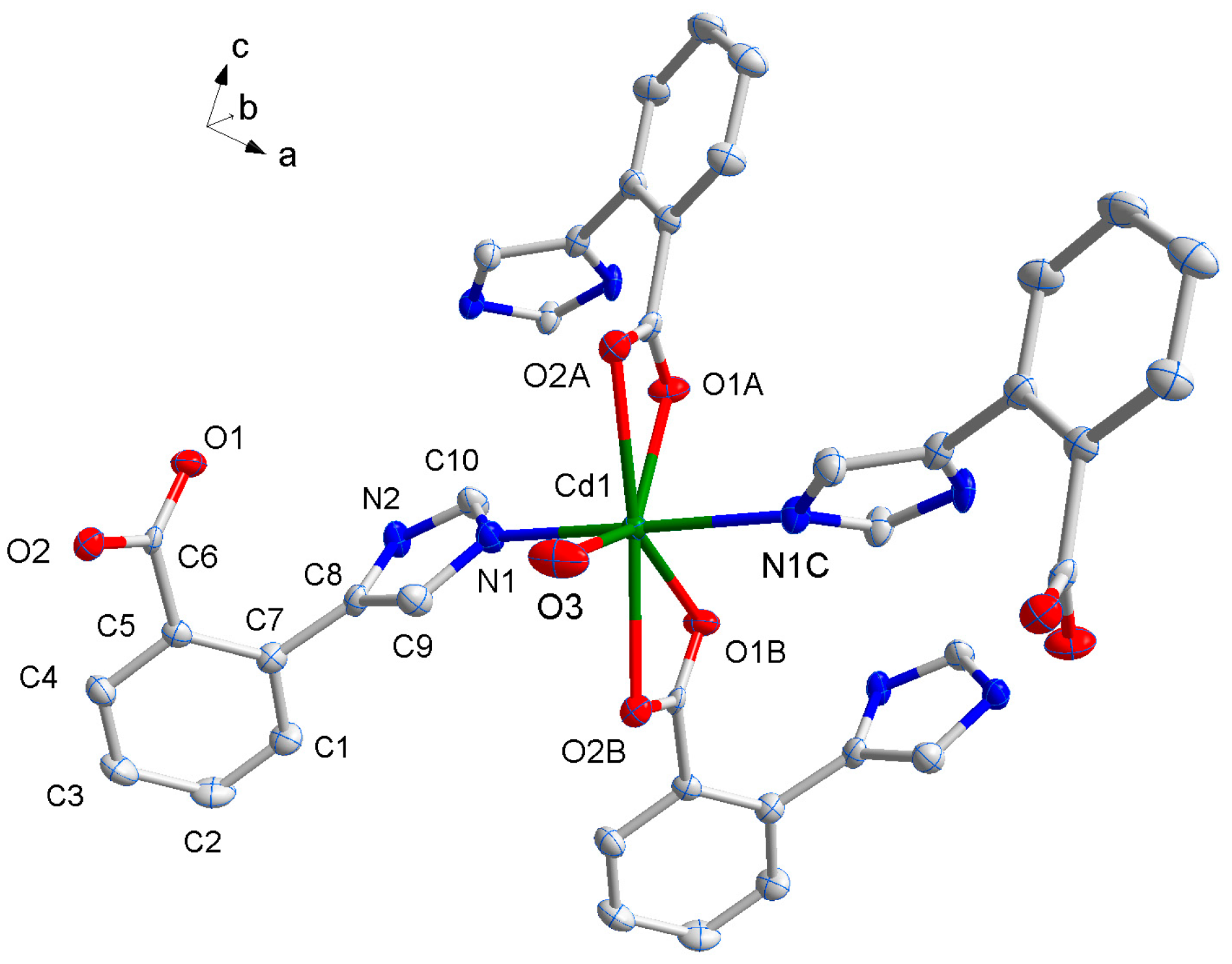
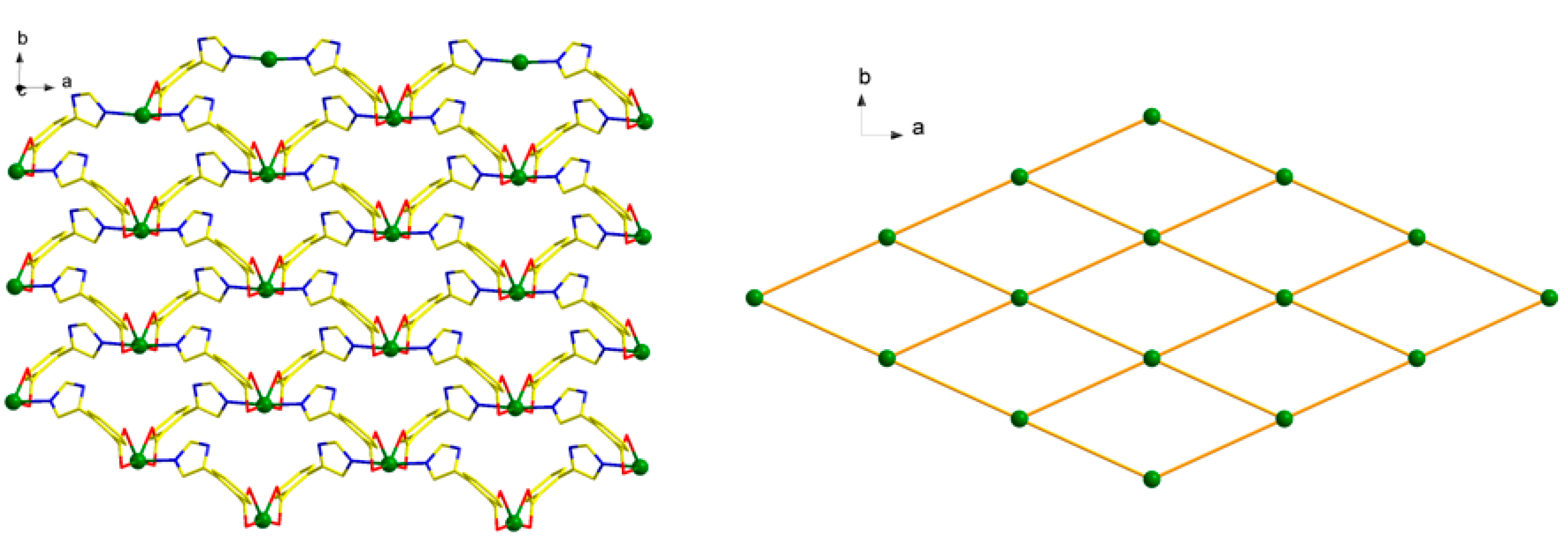
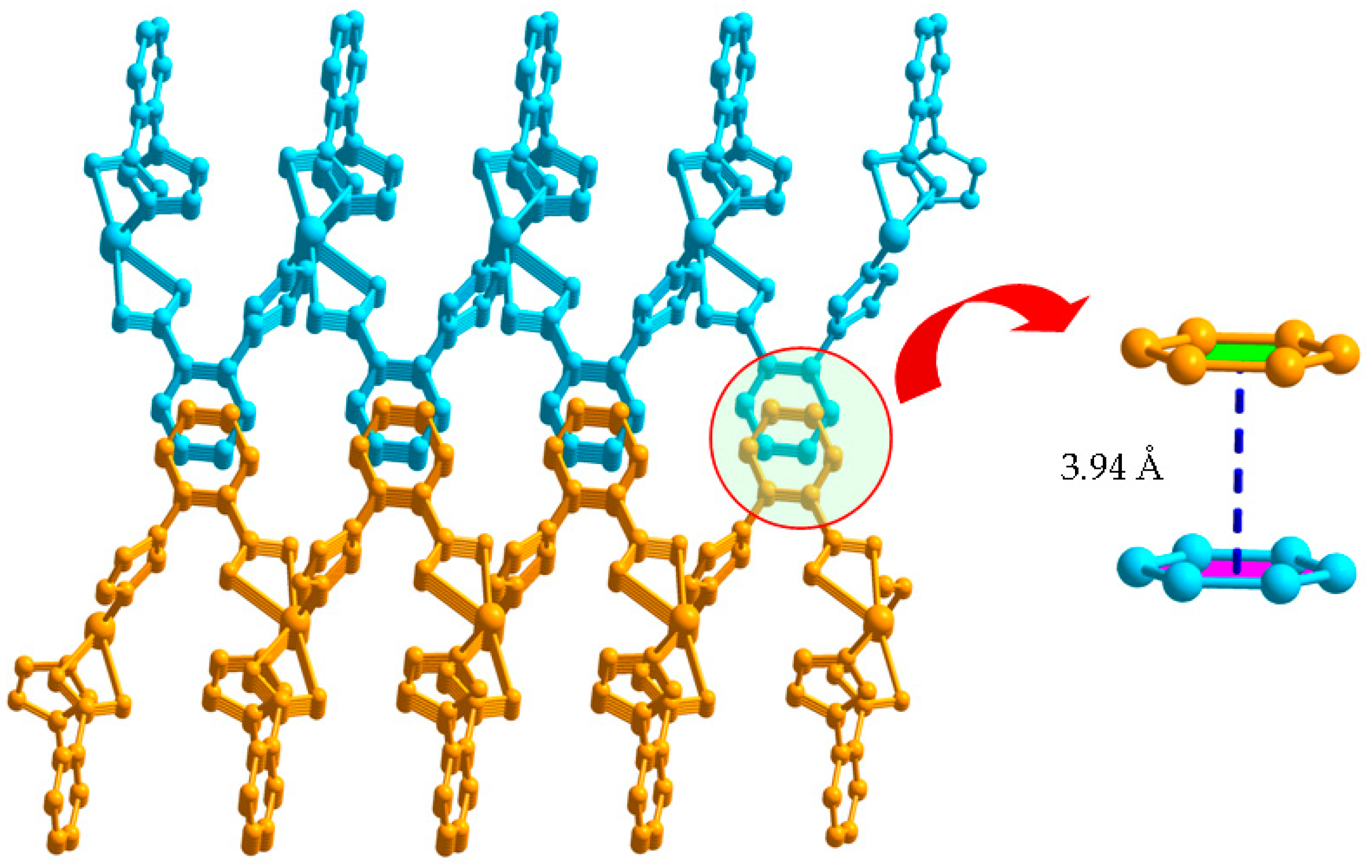

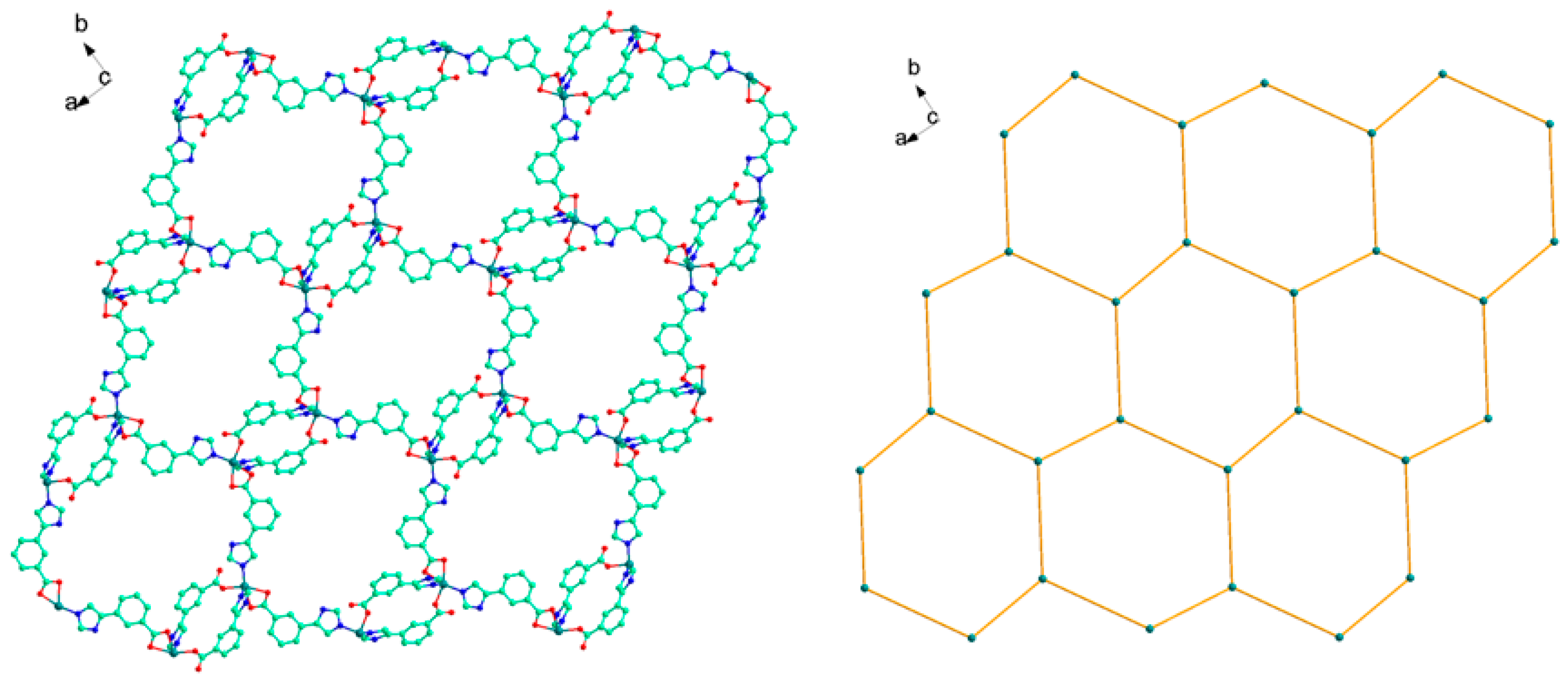
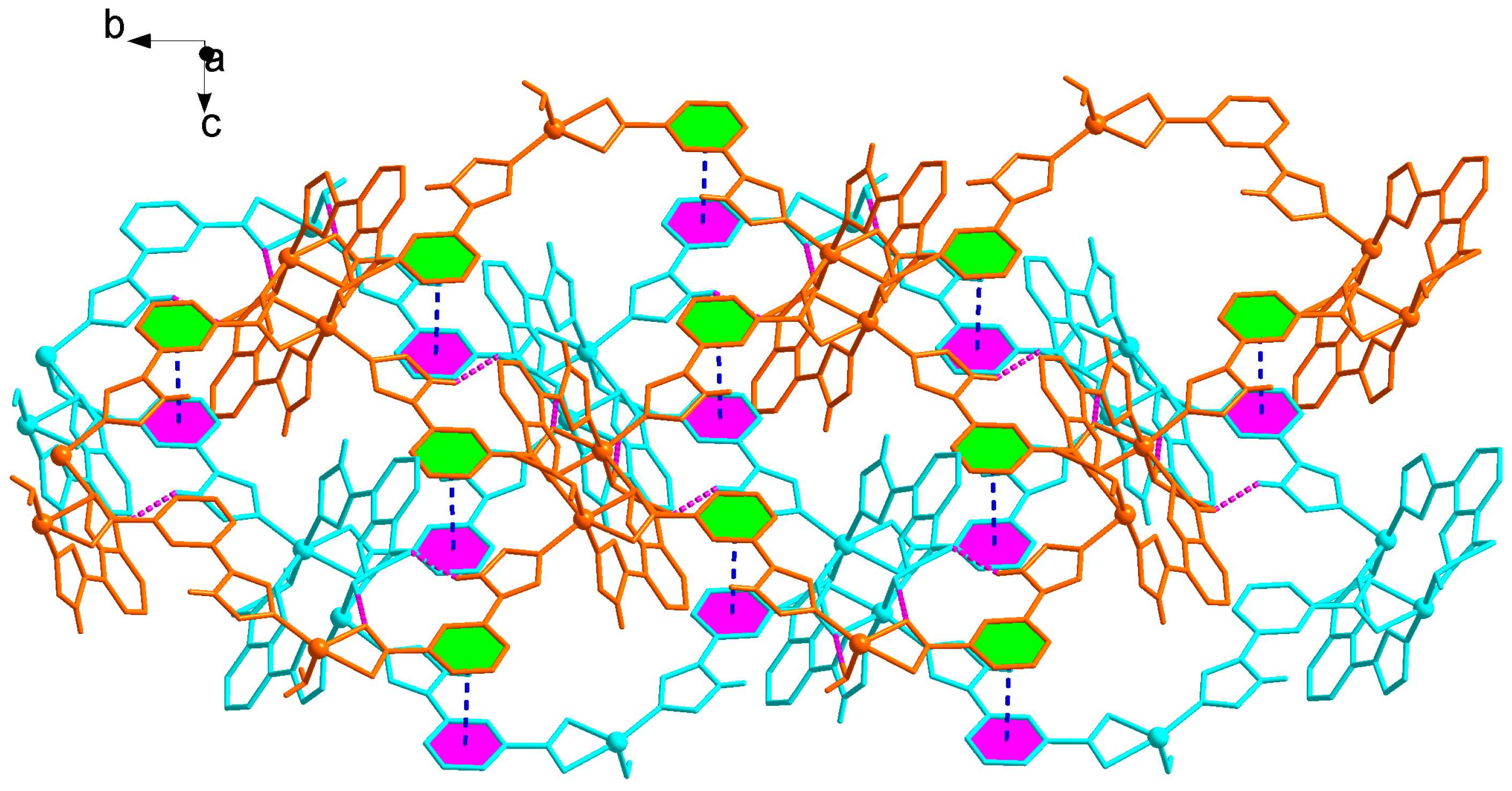
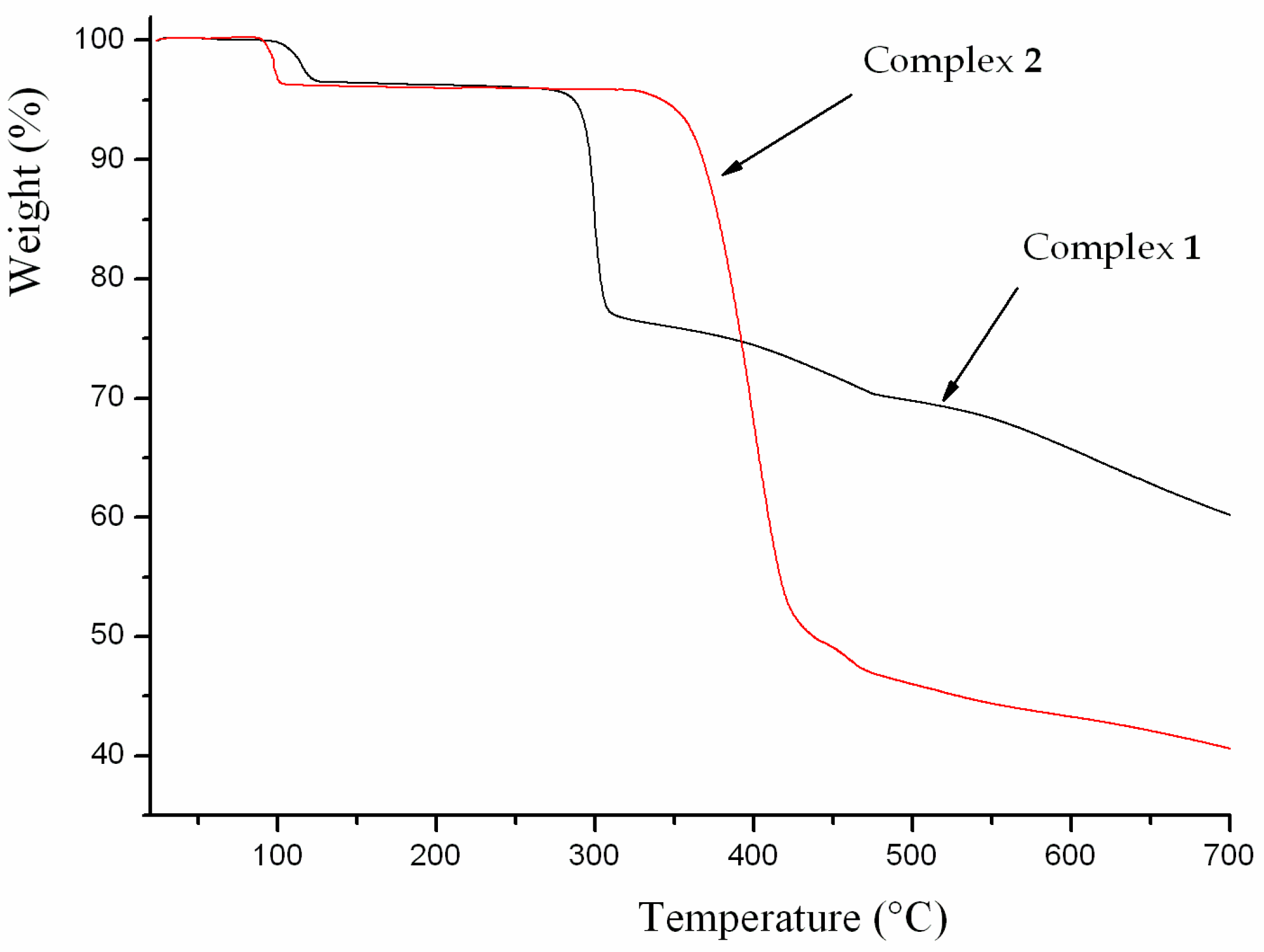
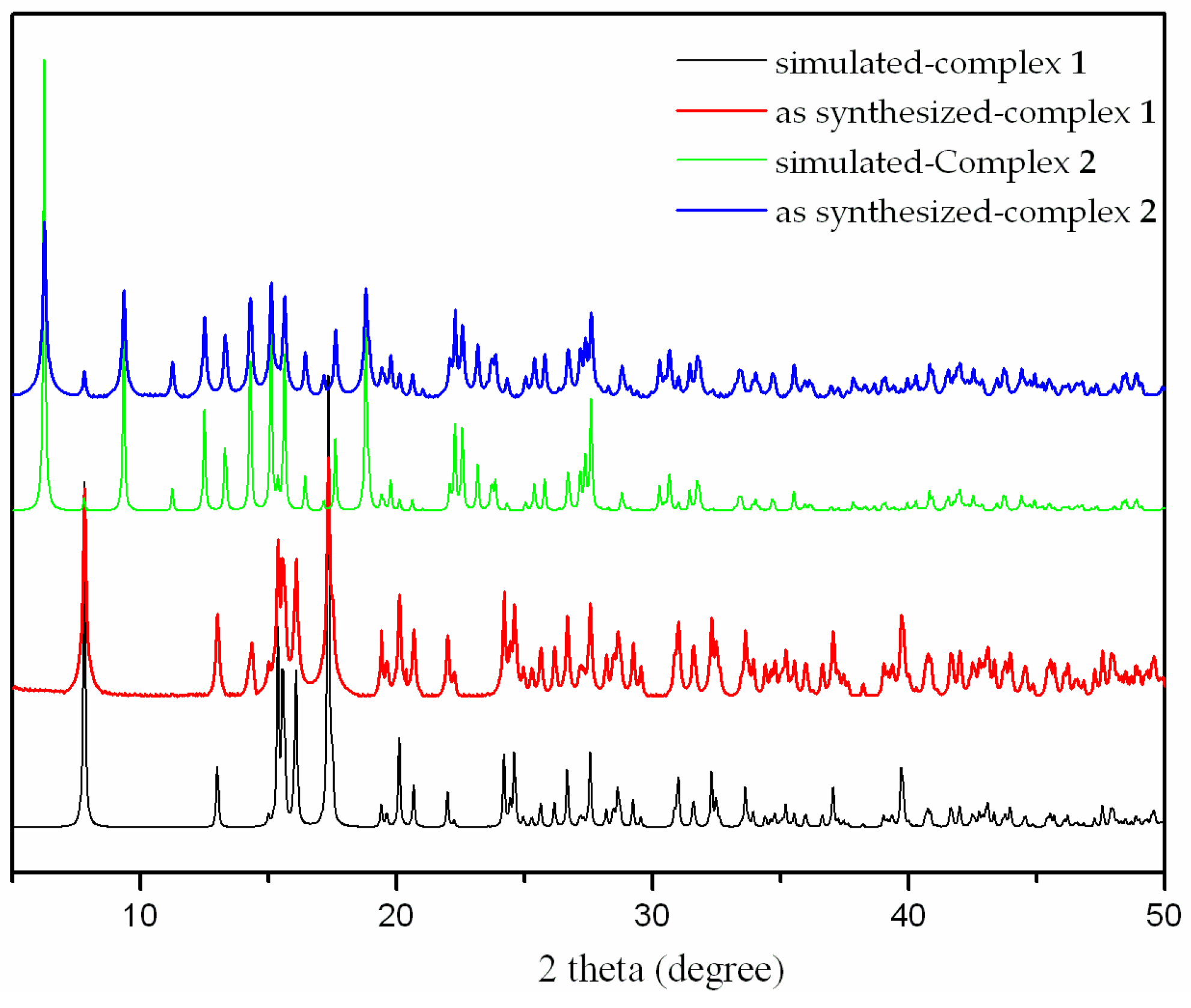
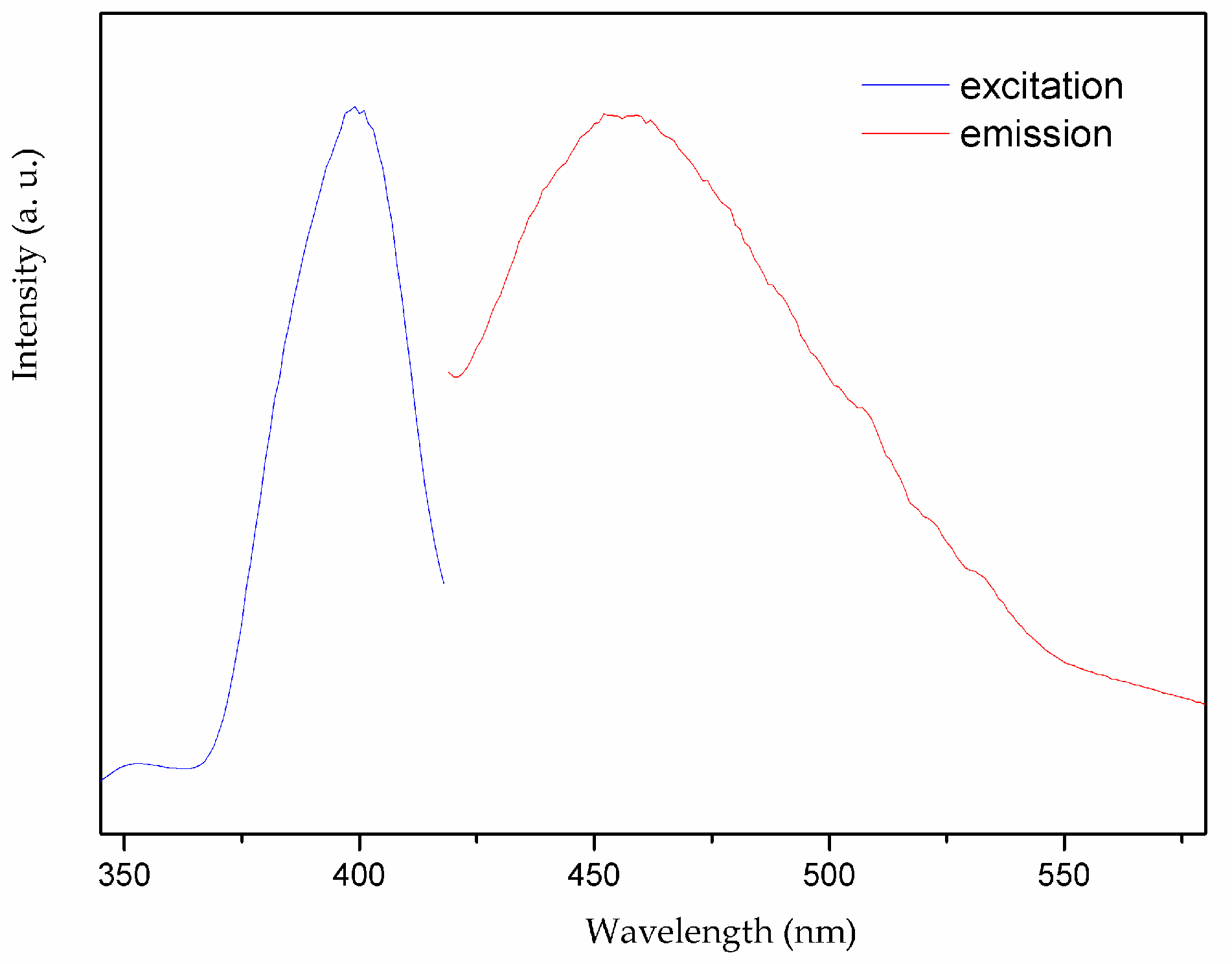
| Bond | d | Bond | d |
|---|---|---|---|
| 1 | |||
| Cd(1)-N(1) | 2.255(8) | Cd(1)-O(3) | 2.298(11) |
| Cd(1)-O(1)ii | 2.438(8) | Cd(1)-O(2)ii | 2.453(7) |
| 2 | |||
| Ni(1)-N(1) | 2.0654(13) | Ni(1)-N(3)v | 2.0252(13) |
| Ni(1)-O(2)iv | 2.0123(11) | Ni(1)-O(3) | 2.1211(11) |
| Ni(1)-O(5) | 2.1475(12) | Ni(1)-O(4) | 2.1541(10) |
| Angle | ω | Angle | ω |
| 1 | |||
| N(1)-Cd(1)-N(1)i | 173.9(5) | N(1)-Cd(1)-O(3) | 93.0(2) |
| N(1)-Cd(1)-O(1)ii | 88.3(3) | O(3)-Cd(1)-O(1)ii | 136.76(17) |
| (1)ii-Cd(1)-O(1)iii | 86.5(3) | N(1)-Cd(1)-O(2)ii | 86.0(3) |
| N(1)-Cd(1)-O(2)iii | 94.7(3) | O(3)-Cd(1)-O(2)ii | 83.46(15) |
| O(1)ii-Cd(1)-O(2)ii | 53.5(2) | O(1)iii-Cd(1)-O(2)ii | 139.5(2) |
| O(2)ii-Cd(1)-O(2)iii | 166.9(3) | ||
| 2 | |||
| O(2)iv-Ni(1)-N(3)v | 97.46(5) | O(2)iv-Ni(1)-N(1) | 94.27(5) |
| N(3)v-Ni(1)-N(1) | 91.25(5) | O(2)iv-Ni(1)-O(3) | 94.49(4) |
| N(3)v-Ni(1)-O(3) | 168.06(5) | N(1)-Ni(1)-O(3) | 87.95(5) |
| O(2)iv-Ni(1)-O(5) | 89.39(5) | N(3)v-Ni(1)-O(5) | 91.36(5) |
| N(1)-Ni(1)-O(5) | 175.19(5) | O(3)-Ni(1)-O(5) | 88.66(4) |
| O(2)iv-Ni(1)-O(4) | 155.91(4) | N(3)v-Ni(1)-O(4) | 106.31(5) |
| N(1)-Ni(1)-O(4) | 89.15(5) | O(3)-Ni(1)-O(4) | 61.77(4) |
| O(5)-Ni(1)-O(4) | 86.24(4) | ||
| D–H···A | d(D–H) | d(H···A) | d(D···A) | ∠DHA |
| 1 | ||||
| N(2)–H(2)···O(2)i | 0.86 | 1.99 | 2.83(11) | 166 |
| 2 | ||||
| N(2)–H(2A)···O(3)ii | 0.86 | 2.07 | 2.89(17) | 157 |
| N(4)–H(4)···O(1)iii | 0.86 | 2.09 | 2.83(18) | 144 |
| O(5)–H(5A)···O(1)iv | 0.82 | 2.00 | 2.73(16) | 147 |
| O(5)–H(5B)···O(4)v | 0.83 | 1.96 | 2.78(16) | 176(2) |
| C(5)–H(5)···O(2) | 0.93 | 2.40 | 2.73(18) | 100 |
| Empirical Formula | C20H16N4O5Cd | C20H16N4O5Ni |
|---|---|---|
| Formula weight | 503.76 | 451.08 |
| Temperature/K | 296(2) | 296(2) |
| Crystal system | Monoclinic | Monoclinic |
| Space group | C2/c | P21/c |
| a/Å | 13.614(5) | 14.2023(15) |
| b/Å | 6.270(2) | 18.929(2) |
| c/Å | 22.659(8) | 7.1289(8) |
| α/° | 90 | 90 |
| β/° | 91.574(6) | 94.382(2) |
| γ/° | 90 | 90 |
| Volume/Å3 | 1933.4(12) | 1910.9(4) |
| Z | 4 | 4 |
| ρcalcmg/mm3 | 1.727 | 1.568 |
| μ/mm−1 | 1.171 | 0.932 |
| F(000) | 1000 | 928 |
| Index ranges | −16 ≤ h ≤ 17, −8 ≤ k ≤ 8, −13 ≤ l ≤29 | −18 ≤ h ≤ 18, −24 ≤ k ≤ 23, −9 ≤ l ≤ 5 |
| Reflections collected | 5530 | 12981 |
| Independent reflections | 2179 | 4389 |
| Data/restraints/parameters | 2179/0/137 | 4389/0/276 |
| Goodness-of-fit on F2 | 1.079 | 1.034 |
| Final R indexes [I> = 2σ (I)] | R1 = 0.0759, wR2 = 0.2339 | R1 = 0.0253, wR2 = 0.0648 |
| Final R indexes [all data] | R1 = 0.0808, wR2 = 0.2419 | R1 = 0.0307, wR2 = 0.0678 |
| Largest diff. peak/hole / e Å-3 | 2.658/−3.735 | 0.307 /−0.264 |
© 2017 by the authors. Licensee MDPI, Basel, Switzerland. This article is an open access article distributed under the terms and conditions of the Creative Commons Attribution (CC BY) license (http://creativecommons.org/licenses/by/4.0/).
Share and Cite
Zhu, M.-A.; Guo, X.-Z.; Shi, S.-S.; Chen, S.-S. Synthesis, Crystal Structures, and Photoluminescent Properties of Two Supramolecular Architectures Based on Difunctional Ligands Containing Imidazolyl and Carboxyl Groups. Crystals 2017, 7, 228. https://doi.org/10.3390/cryst7070228
Zhu M-A, Guo X-Z, Shi S-S, Chen S-S. Synthesis, Crystal Structures, and Photoluminescent Properties of Two Supramolecular Architectures Based on Difunctional Ligands Containing Imidazolyl and Carboxyl Groups. Crystals. 2017; 7(7):228. https://doi.org/10.3390/cryst7070228
Chicago/Turabian StyleZhu, Mei-An, Xing-Zhe Guo, Shan-Shan Shi, and Shui-Sheng Chen. 2017. "Synthesis, Crystal Structures, and Photoluminescent Properties of Two Supramolecular Architectures Based on Difunctional Ligands Containing Imidazolyl and Carboxyl Groups" Crystals 7, no. 7: 228. https://doi.org/10.3390/cryst7070228






